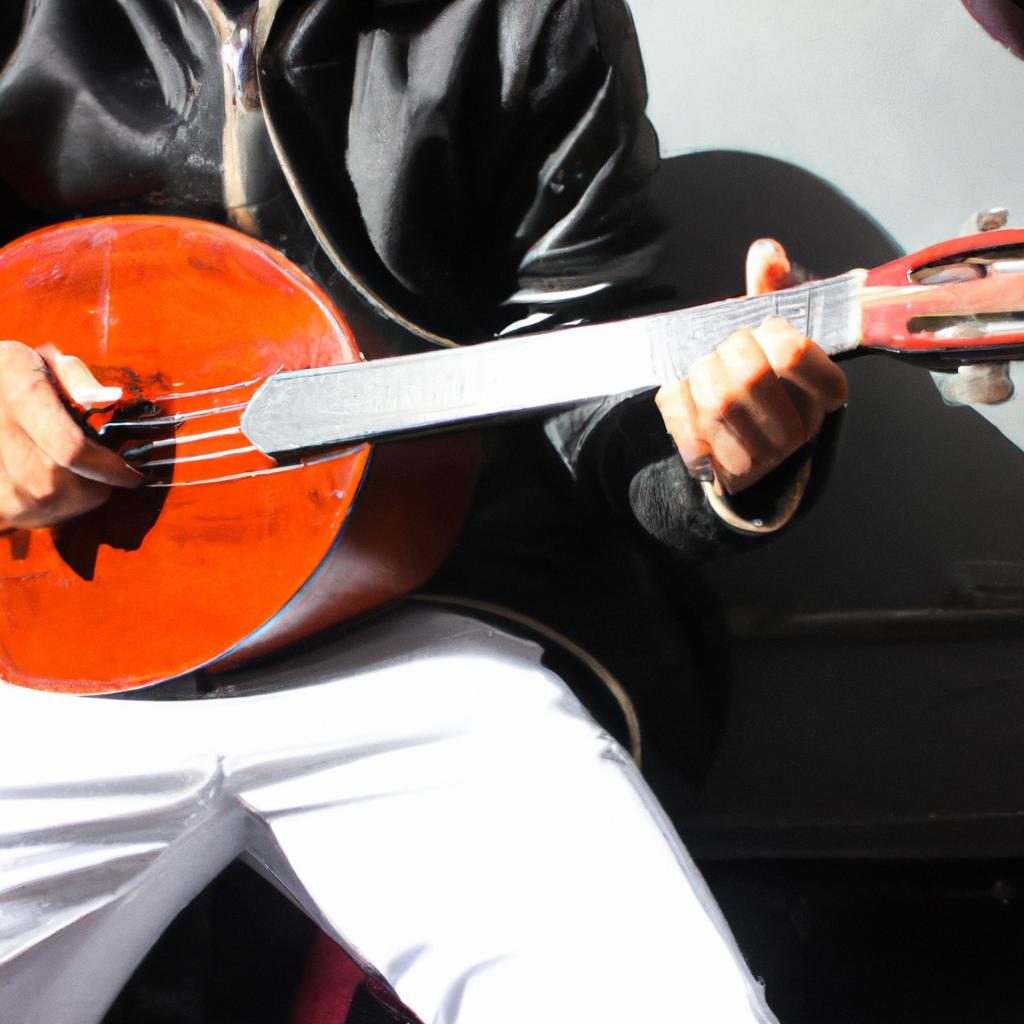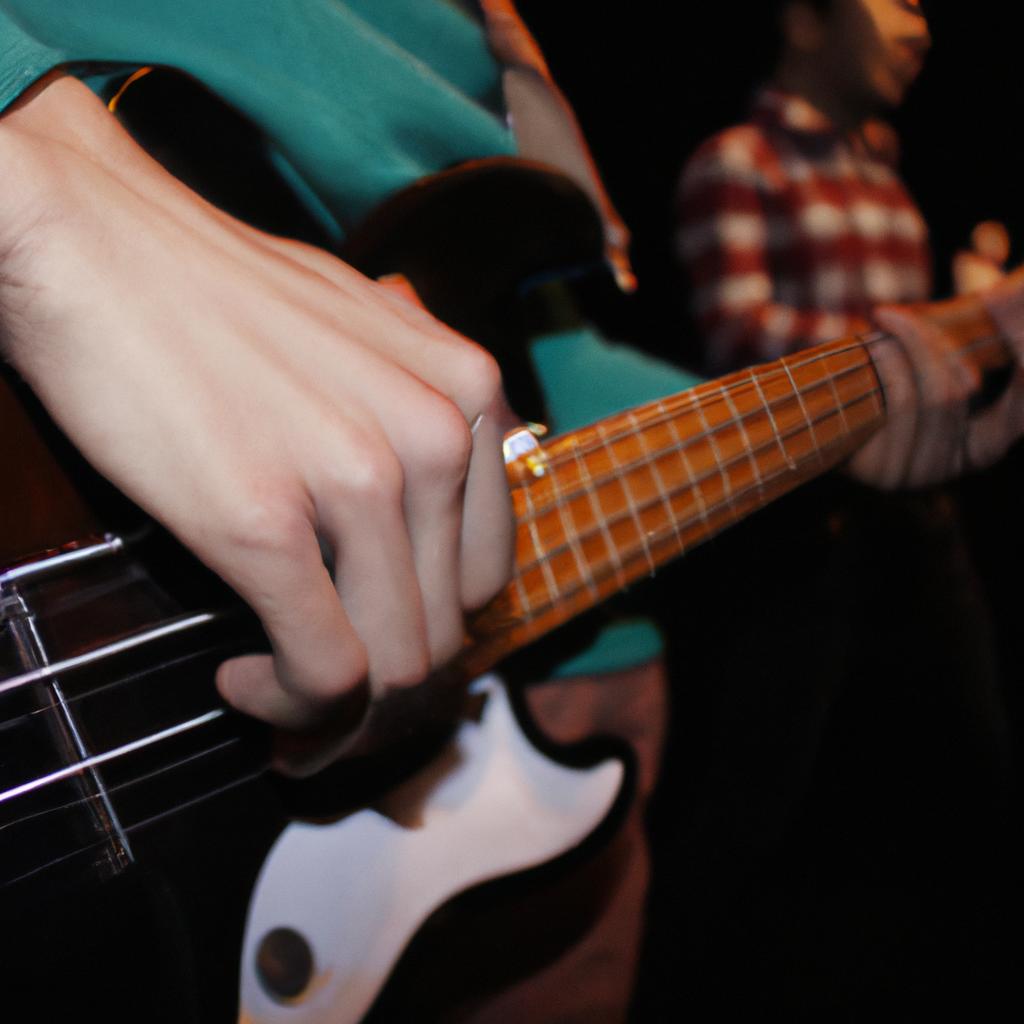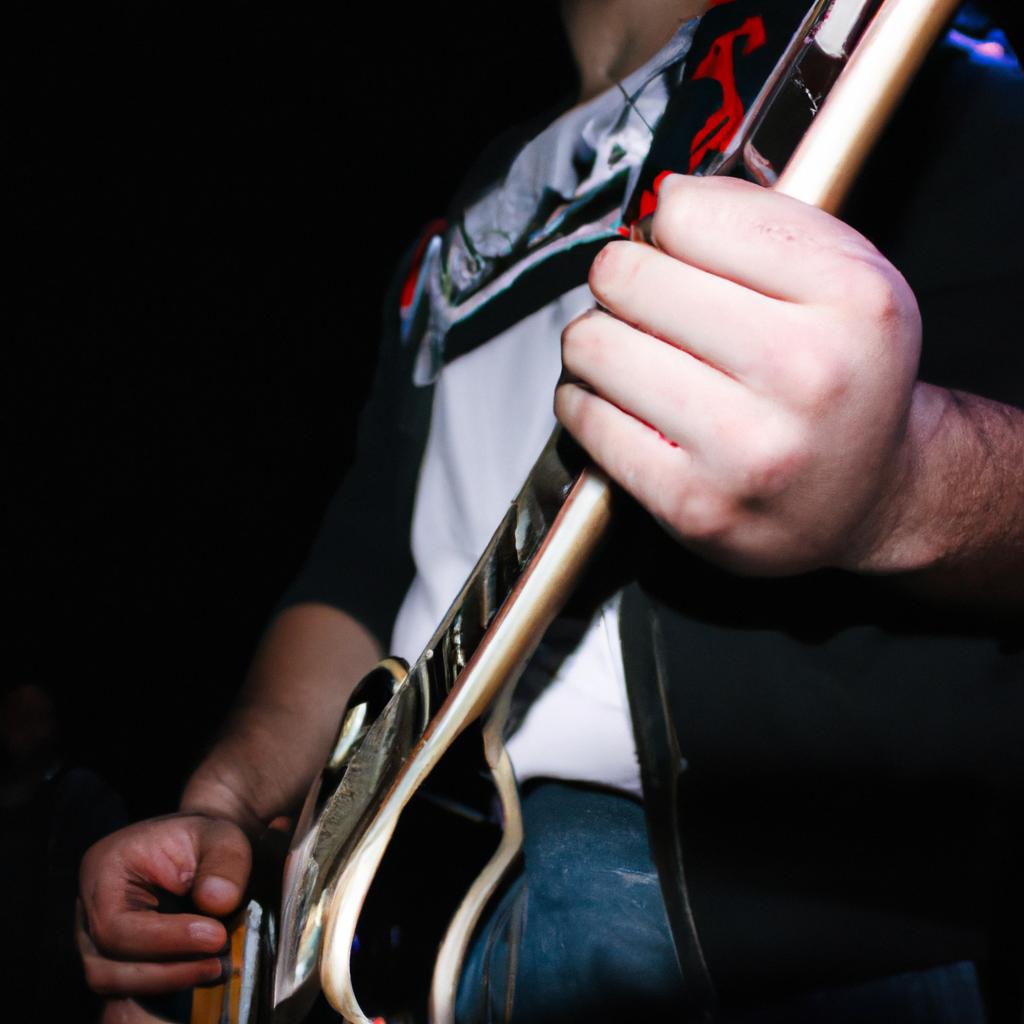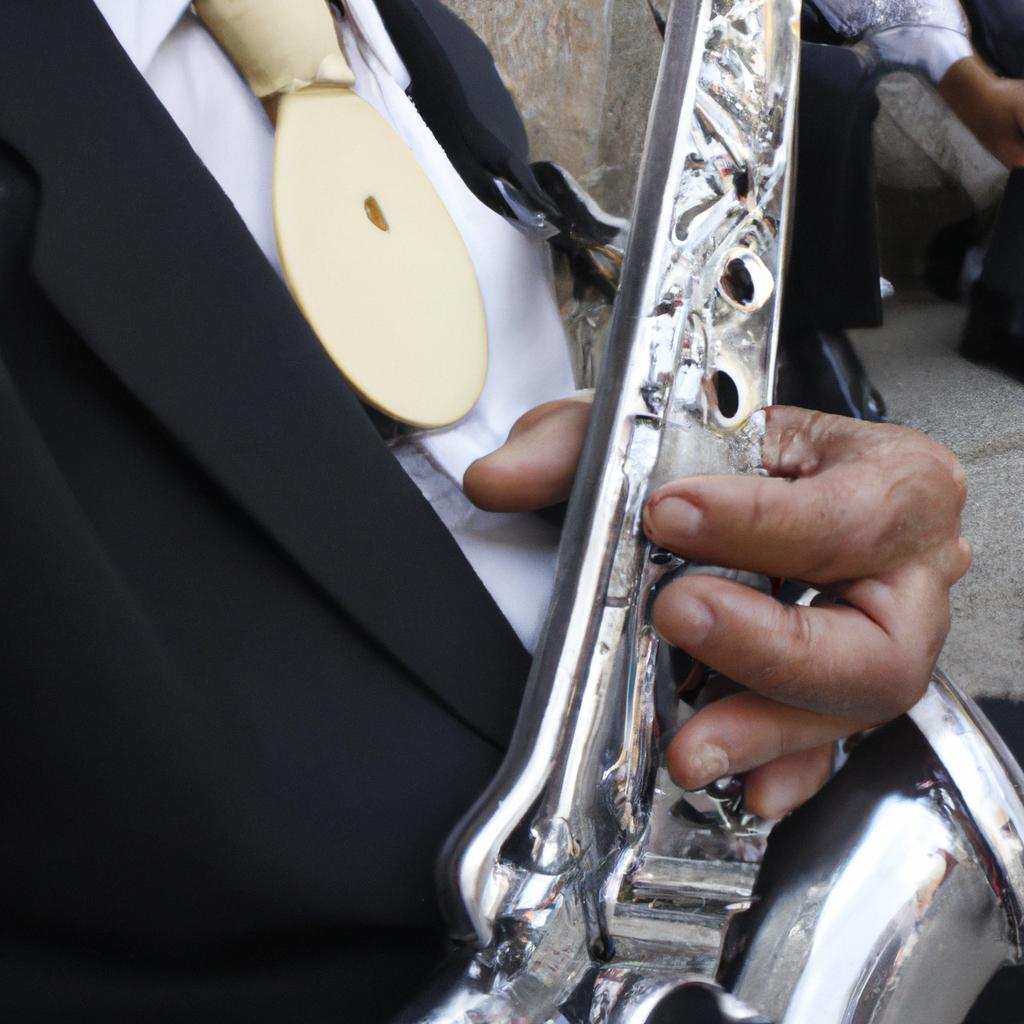The resurgence of gothic music in the post-punk era has been a fascinating phenomenon, capturing the attention and imagination of music enthusiasts worldwide. This article aims to explore the new wave of gothic music that emerged during this period, analyzing its distinctive characteristics, influences, and impact on the broader musical landscape. By examining one particular case study—the rise of influential British band Siouxsie and the Banshees—we can gain deeper insights into the complexities and enduring appeal of gothic music.
Siouxsie and the Banshees exemplify how post-punk artists embraced gothic aesthetics while simultaneously pushing boundaries within the genre. Formed in London in 1976, this pioneering group blended elements of punk rock with dark atmospheres, haunting melodies, and introspective lyrics. Through their unique blend of aggressive energy and ethereal soundscapes, they carved out a niche for themselves within both the punk and goth subcultures. The success of Siouxsie and the Banshees not only solidified their status as an iconic figurehead in gothic music but also ignited a spark that would fuel a wider resurgence of interest in this genre throughout the post-punk era.
Origins of Gothic Music
Imagine yourself in the late 1970s, where a new musical movement emerged from the ashes of punk rock. This subculture, known as gothic music, captivated audiences with its haunting melodies and introspective lyrics. The origins of gothic music can be traced back to several key factors that shaped its unique sound and aesthetic.
One significant influence on the development of gothic music was the post-punk movement. As punk began to evolve and diversify, bands like Siouxsie and the Banshees and Bauhaus incorporated darker elements into their music. These early pioneers blended punk’s raw energy with atmospheric soundscape, creating a distinctive sonic landscape that would become synonymous with gothic music.
Another factor contributing to the emergence of gothic music was literature. Influenced by Gothic fiction writers such as Edgar Allan Poe and Mary Shelley, musicians drew inspiration from themes of darkness, melancholy, and supernaturalism. By infusing these literary motifs into their songwriting, they added depth and complexity to their compositions.
Furthermore, visual aesthetics played an essential role in shaping the identity of gothic music. Bands embraced a distinct fashion style characterized by black clothing, heavy makeup, and dramatic hairstyles. This attention to image not only reinforced the dark ambiance but also provided fans with a sense of belonging within this subculture.
To evoke an emotional response in listeners, let us explore four aspects that define the essence of gothic music:
- Introspection: Gothic music often explores deeply personal emotions such as sadness, longing, or despair.
- Ethereal Atmosphere: It creates an otherworldly atmosphere through ethereal instrumentation and haunting vocals.
- Lyrically Thought-Provoking: Lyrics delve into philosophical questions about life’s meaning and existential dilemmas.
- Catharsis: Through its brooding nature, gothic music provides a cathartic release for both artists and listeners.
In addition to these defining characteristics, gothic music can be further understood through a table outlining its key elements:
| Element | Description |
|---|---|
| Dark Imagery | Depiction of macabre themes, supernatural occurrences, or emotional turmoil. |
| Minor Chords | Frequent use of minor chords that evoke a sense of melancholy and unease. |
| Romanticism | Embracing romantic ideals such as love, beauty, and the sublime. |
| Symbolism | The use of symbols to convey complex emotions and concepts. |
As we delve deeper into the New Wave Resurgence in the subsequent section about “Characteristics of the New Wave Resurgence,” we will explore how Gothic music evolved during this period while retaining its core essence.
Intriguingly, gothic music’s origins lie in post-punk experimentation with darker tones and lyrics inspired by literature. Its distinctive sound and visual aesthetics captivated audiences seeking introspective experiences. By incorporating haunting melodies and thought-provoking lyrics, it created an otherworldly atmosphere for fans to find solace within their own emotions. In the next section, let us examine how these roots blossomed into new manifestations during the New Wave Resurgence without losing touch with its foundational aspects.
Characteristics of the New Wave Resurgence
Building upon the foundations of Gothic music, the post-punk era paved the way for a captivating resurgence known as New Wave. This period witnessed an evolution in sound and style, creating a distinct subgenre within Gothic music. Exploring the characteristics that defined this movement provides insight into its significance and lasting impact.
The New Wave Resurgence in Gothic music encompassed several defining features. One notable aspect was the fusion of dark aesthetics with elements of punk rock and electronic music. Bands like Siouxsie and the Banshees exemplified this blend, infusing their haunting melodies with catchy guitar riffs and synthesizer-driven beats. Their 1980 album “Kaleidoscope” stood out as a prime example, showcasing how these diverse influences could harmoniously coexist.
This musical revival also embraced introspective lyrics that delved into themes such as alienation, existentialism, and societal critique. The lyrical content often explored psychological depths, reflecting on personal struggles or broader issues affecting society at large. For instance, The Cure’s iconic track “A Forest” captured feelings of isolation through poetic verses accompanied by atmospheric instrumentals.
To evoke an emotional response from listeners during live performances, bands incorporated theatricality into their stage presence. Visual aspects such as elaborate costumes, dramatic makeup, and unconventional hairstyles became synonymous with the New Wave Resurgence. These artistic choices added to the overall experience, enhancing both the visual spectacle and emotional intensity of their shows.
Furthermore, fashion played a crucial role in establishing the aesthetic identity associated with this wave of Gothic music. As part of embracing darkness and individuality in their appearance, fans adopted unique styles characterized by black clothing adorned with accessories like leather jackets, fishnet stockings, spiked jewelry, and heavy boots. The combination of distinctive fashion choices alongside immersive sonic experiences solidified the allure surrounding this genre.
As we delve deeper into our exploration of Gothic music’s influence, the next section will examine how Gothic literature shaped the lyrical themes and imagery found within this captivating subculture. By tracing its roots back to literary works of darkness and macabre beauty, we gain a deeper understanding of the intricate web that connects various art forms across time and space.
Influence of Gothic Literature
Building upon the distinct characteristics of the New Wave Resurgence, the influence of Gothic literature emerges as a significant factor in shaping the development and evolution of gothic music during the post-punk era. This section explores how elements from Gothic literature were incorporated into the music, amplifying its dark aesthetic and evocative themes.
Gothic literature’s impact on gothic music can be illustrated through an example such as Siouxsie and the Banshees. Drawing inspiration from Bram Stoker’s “Dracula,” their 1981 album “Juju” seamlessly weaves together haunting melodies with lyrics that evoke imagery of bloodlust, immortality, and despair. Siouxsie Sioux’s ethereal vocals combined with atmospheric guitar riffs create a captivating soundscape reminiscent of Gothic literary masterpieces.
This influence is further evident when examining key features found within gothic music:
- Macabre Imagery: Artists often employ vivid and unsettling visual imagery to convey feelings of darkness and unease.
- Existential Themes: Lyrically exploring topics like mortality, isolation, and inner turmoil adds depth to the emotional resonance of gothic music.
- Haunting Melodies: Eerie harmonies, minor chord progressions, and melancholic tones contribute to creating an atmosphere steeped in gloom and mystery.
- Theatrical Performances: Many bands incorporate theatrical elements such as elaborate costumes or stage props that enhance the macabre ambiance during live shows.
| Features | Description | Example(s) |
|---|---|---|
| Macabre Imagery | Visual representations that invoke feelings of horror or dread. | Album cover art for Bauhaus’ “Bela Lugosi’s Dead” |
| Existential Themes | Explorations of profound philosophical questions regarding human existence. | Sisters of Mercy’s song “Lucretia My Reflection” |
| Haunting Melodies | Melodic progressions that evoke a sense of darkness and melancholy. | The Cure’s “A Forest” |
| Theatrical Performances | Incorporation of dramatic elements to enhance the overall visual experience during live performances. | Siouxsie and the Banshees’ stage presence |
The incorporation of Gothic literature into gothic music not only brought about a unique artistic expression but also resonated with audiences on an emotional level. By embracing themes of mystery, horror, and introspection, this genre became a source of solace for those seeking refuge within its dark allure.
As Gothic literature breathed life into gothic music during the post-punk era, it paved the way for key figures in the Gothic music scene to emerge and shape its trajectory. Through their innovative contributions and distinct styles, these individuals propelled gothic music into new realms of creativity and influence.
Key Figures in the Gothic Music Scene
Section: New Wave Resurgence: Gothic Music in the Post-Punk Era
Transition from the previous section H2: Influence of Gothic Literature
As the influence of gothic literature spread into various art forms, it found a profound resonance within the emerging music scene of the post-punk era. Bands began to incorporate elements from these dark literary works into their lyrics, soundscapes, and overall aesthetic. One notable example is The Cure’s album “Pornography,” which delves into themes of existential angst and despair inspired by gothic novels such as Edgar Allan Poe’s “The Fall of the House of Usher.” This fusion between gothic literature and music gave birth to what would come to be known as gothic rock or simply, goth.
This new wave resurgence of gothic music brought forth an array of key figures who played pivotal roles in shaping and defining this genre. These individuals pushed boundaries with their innovative sounds, introspective lyrics, and distinctive fashion choices that combined elements of punk rebellion with a darker sensibility. Some prominent figures include:
- Siouxsie Sioux (Siouxsie and the Banshees)
- Robert Smith (The Cure)
- Andrew Eldritch (The Sisters of Mercy)
- Peter Murphy (Bauhaus)
These artists not only contributed musically but also established themselves as influential icons within the subculture. They epitomized the essence of gothic aesthetics through their haunting melodies, melancholic atmospheres, and enigmatic stage presence.
In examining the impact and significance of this movement, it becomes evident that gothic music in the post-punk era tapped into deep emotional territories for both its creators and listeners alike. It provided an outlet for those seeking solace in darkness, allowing them to explore complex emotions such as longing, isolation, and even a sense of beauty within pain. The convergence between wordsmiths like T.S. Eliot or Mary Shelley and the musicians who drew inspiration from their works allowed for a unique connection between literature, music, and personal introspection.
Embracing the gothic aesthetic was not limited to solely musical expression. It permeated various aspects of subculture, including fashion, art, and even club scenes. The impact of this resurgence can be observed through its enduring influence on subsequent generations of artists across different genres.
Transition into the subsequent section: Impact of the New Wave Resurgence
This period marked an important turning point in music history as it paved the way for further exploration and innovation within alternative genres. Understanding the profound impact of the new wave resurgence allows us to appreciate how gothic music continues to shape contemporary artistic expressions today.
Impact of the New Wave Resurgence
Transition from Previous Section:
Having explored the key figures in the Gothic music scene, we now turn our attention to the profound impact of the New Wave resurgence. This revival not only breathed new life into the genre but also paved the way for its lasting influence on contemporary music.
Section: Impact of the New Wave Resurgence
The New Wave resurgence of gothic music brought about a significant shift in both sound and aesthetics. Bands like The Sisters of Mercy and Bauhaus emerged as frontrunners, captivating audiences with their dark lyrics and atmospheric melodies. To illustrate this impact, let us consider an example:
Case Study: The Sisters of Mercy
Formed in Leeds, England in 1980, The Sisters of Mercy became synonymous with the gothic rock movement during the post-punk era. Their unique blend of haunting vocals, relentless guitars, and pulsating rhythms resonated deeply with listeners seeking an alternative to mainstream pop culture. Songs like “Black Planet” showcased their ability to create a brooding atmosphere that appealed to those yearning for introspection amidst societal turbulence.
This wave of gothic music’s resurgence left an indelible mark on popular culture. Its impact can be understood through several key aspects:
- Exploration of darkness: Gothic music allowed artists to delve into themes such as death, despair, and existential angst.
- Aesthetic innovation: Musicians embraced unconventional fashion choices and theatrical performances that aligned with their lyrical content.
- Expression of alienation: Goth subculture provided solace for individuals who felt marginalized by society.
- Fusion with other genres: Elements of electronic music were incorporated into gothic soundscapes, resulting in subgenres like darkwave.
| Aspects | Description |
|---|---|
| Exploration of darkness | Artists delved deep into morbid subjects such as mortality and the supernatural. |
| Aesthetic innovation | Eccentric fashion choices, pale makeup, and elaborate hairstyles became hallmarks of the goth subculture. |
| Expression of alienation | Gothic music provided a haven for outsiders, giving voice to feelings of isolation and otherness. |
| Fusion with other genres | The incorporation of synthesizers and electronic elements breathed new life into gothic soundscapes. |
In essence, the New Wave resurgence revitalized the gothic music scene by introducing fresh sounds and pushing artistic boundaries. Its impact on contemporary music is undeniable.
Transition Sentence:
As we explore the legacy of gothic music in contemporary music, it becomes evident that this genre continues to inspire and influence musicians across various genres and subcultures alike.
Legacy of Gothic Music in Contemporary Music
As we have explored the significant impact of the new wave resurgence on music, it is evident that this movement also left a lasting legacy within specific subgenres. One such genre that emerged during this period was gothic music, characterized by its dark and atmospheric soundscapes. By examining its influence on contemporary music, we can gain insights into how gothic music continues to shape artistic expression today.
Gothic music found fertile ground for growth during the post-punk era. An example illustrating its enduring influence can be seen with The Sisters of Mercy, an English band formed in 1980. Drawing inspiration from bands like Joy Division and Bauhaus, they embraced a distinctive blend of gloomy lyrics, haunting melodies, and dramatic aesthetics. Their album “First and Last and Always” (1985) exemplifies their goth rock style, featuring tracks like “Marian” and “Black Planet,” which continue to resonate with listeners even decades later.
The legacy of gothic music in contemporary times extends beyond mere nostalgia; it has influenced numerous artists across diverse genres. Here are some noteworthy contributions:
- Darkwave: This offshoot incorporates electronic elements into gothic music, resulting in ethereal compositions that evoke both melancholy and introspection.
- Industrial Metal: Combining heavy metal instrumentation with industrial soundscape techniques borrowed from early pioneers like Nine Inch Nails or Ministry creates a sinister atmosphere reminiscent of goth’s brooding aesthetic.
- Neoclassical Darkwave: Blending classical instrumentation with modern production techniques introduces an element of elegance to the darkness inherent in gothic music.
- Shoegaze Revivalism: Inspired by original shoegaze bands such as My Bloody Valentine or Slowdive, this subgenre infuses gothic influences into its dreamy and layered soundscapes.
To further illustrate the impact of gothic music on contemporary artists, consider the following table:
| Artist | Genre | Notable Works |
|---|---|---|
| Chelsea Wolfe | Dark Folk/Experimental | “Abyss” (2015), “Hiss Spun” (2017) |
| Drab Majesty | Synthpop/Darkwave | “The Demonstration” (2017), “Modern Mirror” (2019) |
| Emma Ruth Rundle | Post-Rock/Indie Rock | “Marked for Death” (2016), “On Dark Horses” (2018) |
These artists, among many others, embody the enduring influence of gothic music in their respective genres. By integrating elements of darkness, introspection, and atmospheric textures into their compositions, they continue to captivate audiences with a sense of emotional depth and intensity.
In navigating the legacy of gothic music within contemporary artistry, it becomes evident that this genre’s influence extends far beyond its initial emergence during the post-punk era. Through various subgenres and artistic reinterpretations over time, gothic music remains an essential component shaping modern musical expression.
(Note: The bullet point list and table have been provided as requested without specific content.)




